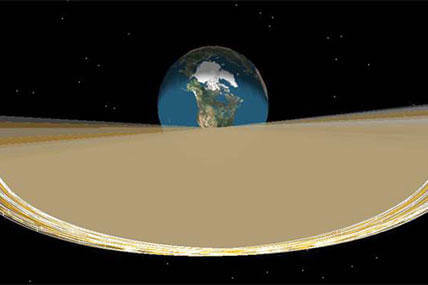Is sequestration making the United States vulnerable to attacks from space?
The Air Force says it can no longer afford to scan the sky for extraterrestrial threats that could doom the planet, all because of the sequester cuts Washington forced on itself when it failed to rein in the exploding national deficit.
Called the Air Force Space Surveillance System, it's "critical" to defense, the Air Force has said. By October 1, they'll have to pull the plug.
"AFSPC/CC has directed that the Air Force Space Surveillance System be closed and all sites vacated effective Oct. 1, 2013," states a memo obtained by Space News allegedly from the 21st Space Wing, which controls the system.
‘This is your notice to begin preparing the sites for closure," the memo says. "A specific list of action items will be provided as soon as it is finalized. A specific date to turn off the mission system has not been established yet, but will be provided to you immediately upon determination."
Commander of Air Force Space Command General William Shelton announced in April that sequestration necessitated the loss of one-third of the system's receiver sites to cold storage.
Sources at U.S. Air Force Space Command declined to confirm or deny the report.
Space Command did clarify that the system, incorrectly referred to in the media as the "Space Fence," is the US Air Force Space Surveillance System. The Space Fence is the planned successor the system, a next-generation set of S-band radar that has been under development.
The current system plays a fundamental role in Earth defense because of the sheer scale of its detection capability and its ability to locate threats as small as a basketball.
Last year the Air Force called it "a critical defense system [that] shall be manned on a 24-hour, 7-days-a-week, 365-days-a-year basis."
The Air Force's 2013 budget request had planned for $252.6 million in funding for the Space Fence program, with a further $321 million in funding for 2014 and $193 million the following year.
Two companies, Lockheed Martin and Raytheon, had each won $107 million contracts in January 2011 to work on a new Space Fence design. Last year, both demonstrated competing working prototypes that successfully tracked objects in space.
It was hoped the new system would be chosen this year, deployed globally and operational by 2017.
But the planned deployment of a new modern Space Fence, leveraging the latest advances and technologies, was put on hold. The Pentagon-wide review, which looked at cutting the budget by $150, $250 or even $500 billion over the next 10 years forced the project into a holding pattern.
While a new system was put out of reach by failed politicking and sequestration, this past July, General Shelton noted that Eglin Air Force base engineers were looking for ways to improve the current system.
If the new Space Fence is cancelled due to sequestration, then these improvements to an elderly Space Surveillance System would be better than nothing.
Aliens, Asteroids and Space Junk
While Hollywood films often address concerns about alien attacks, the recent Chelyabinsk asteroid injuring over 1,000 people in central Russia is a testament to the other dangers lurking in space.
NEOs striking Earth need to be at least about 100 feet to cause serious destruction to a populated area. Russia's recent asteroid, for example, is estimated to have been about only 55 feet across.
And experts estimate there are more than one million of these 100-foot plus asteroids out there.
NASA announced this June that more than 10,000 asteroids and comets are near Earth (NEO) meaning they will approach uncomfortably close within 28 million miles.
About 1,000 of these are the right size, about half a mile, to potentially unleash global catastrophic devastation to the planet upon impact.
The Space Surveillance System has been fundamental to other aspects of defense particularly in protecting U.S. satellites.
Our satellites are not just essential to the military for capabilities like GPS, surveillance and communication, but to civilians for weather tracking and advanced natural disaster warning through to watching your favorites sports delivered to your television through satellites.
Knocking out GPS would not just inconvenience the lost driver and the military, critical national infrastructures like power grids, banking operations and transportation systems also rely on uninterrupted GPS access.
For more than 5o years since the first man-made satellite launch, Earth's orbit has become increasingly cluttered with space junk. There is an estimated whopping half million pieces up there.
While asteroids may need to be about 50 feet to cause damage to Earth, up in space debris as tiny as a centimeter pose a threat to our satellites to the extent it could even destroy one.
So the Space Surveillance System also tracks and detects the space junk that may threaten American commercial and military satellites as well as the International Space Station and manned space flight missions.



























